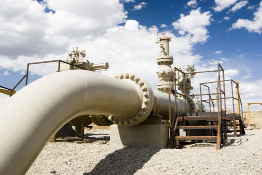Module 2
1. Module 2
1.15. Page 5
Module 2: The Imperial System
Lesson Summary

© Jim Parkin/shutterstock
Natural gas from western Canada flows through pipelines to markets across North America. Consumers are billed based on the amount of gas they use. If your home uses natural gas for heating, ask to see last month’s bill to find out how much natural gas your home used. The volume of natural gas you consumed was most likely quoted in thousands of cubic feet and then converted to an energy equivalent. The cubic foot is a measure of volume in the imperial system.
In this lesson you explored the following lesson questions:
- How are volumes and capacity commonly measured in the imperial system?
- What is the history of volume and capacity units in the imperial system?
- How are volume and capacity units in the imperial system related?
- How are volume and capacity units in the imperial system applied in practical situations?
Check your level of understanding of the materials covered in this lesson by completing “Lesson 3 Traffic Lights.” If you select an amber or red traffic light in the multimedia piece, you will receive information about additional work you can complete to improve your understanding of the topics. Complete the suggested work before you proceed to the Lesson 3 Assignment. If you experience difficulty, contact your teacher before starting the Lesson 3 Assignment.
 Assignment
Assignment
Retrieve the Lesson 3 Assignment Booklet you saved in your course folder at the start of this lesson. Complete the Assignment. Resave your Assignment Booklet in your course folder and submit a copy to your teacher for assessment.
Unit Project
Before you move on to the next lesson, you should start to address the volume components in the Unit 1 Project by applying the skills you mastered in this lesson. For more information about this step and later steps of the Unit Project, refer to the Unit 1 Project.